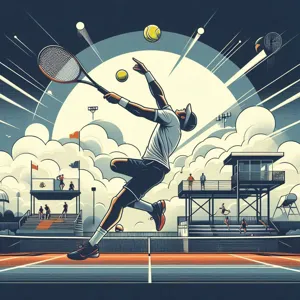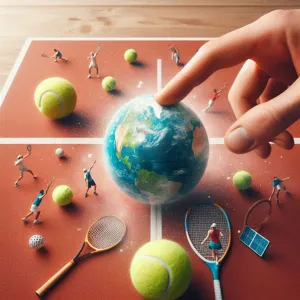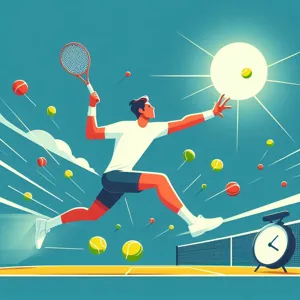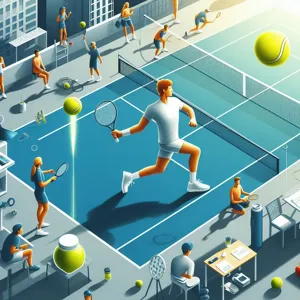In the world of tennis, the lob return can be a game-changer, transforming a defensive play into an offensive opportunity with just the right touch.
Whether you’re facing a towering opponent at the net or trying to escape a tight spot on the court, mastering this essential shot can elevate your game to new heights. But perfecting the lob return requires more than just a keen eye and quick reflexes; it demands a blend of technique, strategy, and practice. In this comprehensive guide, we’ll delve into top techniques and drills designed to enhance your lob return skills. From understanding the nuances of timing and angle to incorporating targeted drills that sharpen your precision and control, this post is your roadmap to tennis success. Get ready to turn those challenging moments into opportunities and leave your opponents scrambling with your newfound prowess!
1. Understanding the Lob Return: What It Is and Why It Matters

Understanding the lob return is essential for any tennis player looking to elevate their game. The lob return is a strategic shot that involves hitting the ball high over your opponent’s head, aiming to land it deep in their court. It’s not just a defensive maneuver; it’s a powerful tool that can shift the momentum of a match. By mastering this technique, you can effectively counter aggressive players who like to attack the net, forcing them into a position of retreat and giving yourself the opportunity to regain control of the point.
Why does the lob return matter? In tennis, positioning and shot selection are pivotal to success. When faced with a hard serve or an opponent who frequently approaches the net, relying solely on traditional returns can limit your options and leave you vulnerable. The lob return allows you to exploit your opponent’s positioning, particularly if they are too close to the net. By sending the ball high and deep, you can disrupt their rhythm and create opportunities for your own offensive plays.
Moreover, the lob return can be a game-changer in doubles play, where opponents often crowd the net. A well-executed lob can not only clear the net-rushers but also create confusion and hesitation in the opposing team, opening up the court for your partner to seize control.
In essence, understanding the lob return is about recognizing its strategic importance and its potential to enhance your overall gameplay. As we delve deeper into techniques and drills, you’ll learn how to integrate the lob return into your arsenal, transforming it from a rarely-used shot into a reliable weapon that keeps your opponents guessing and enhances your chances of success on the court.
2. Key Elements of a Successful Lob Return
When it comes to mastering the lob return in tennis, understanding the key elements that contribute to a successful execution is essential. The lob return is not merely a defensive shot; it can also be a powerful weapon to disrupt your opponent’s rhythm and take control of the point. Here are the crucial components to focus on:
**1. Anticipation and Positioning:** The first step in executing an effective lob return is to anticipate your opponent’s serve. Watch their body language and racket position to gauge the type of serve they are about to deliver. Position yourself accordingly in the court, ideally on your toes, ready to spring into action. Being in the right place at the right time allows for better timing and execution of your lob return.
**2. Grip and Racket Angle:** A comfortable grip is vital when preparing to hit a lob return. While a continental grip is commonly recommended for versatility, feel free to adjust based on your comfort level and the ball’s trajectory. The angle of your racket face should be slightly open, allowing the ball to ascend into the air. This will help you lift the ball over your opponent’s head and provide the necessary arc for a successful lob.
**3. Swing Path and follow-Through:** Your swing should be smooth and fluid, starting low and following through high. A low-to-high swing path is crucial for generating the lift needed for a lob. As you make contact with the ball, focus on pushing through it with your racket, then let your follow-through naturally finish above your shoulder. This motion not only helps in getting the ball over the net but also adds depth to your lob return.
**4. Depth and Placement:** A successful lob return should not only clear the net but also land deep in your opponent’s court, ideally near the baseline. This forces them to retreat, giving you a better chance to regain control of the rally. Experiment with different placements—aim for the corners or the middle of the court—to keep your opponent guessing and off-balance.
**5. Mental Focus:** Lastly, a successful lob return requires mental clarity and focus. Visualize the shot before execution and trust your instincts. Staying calm under pressure will help you maintain your composure and make better decisions during fast-paced exchanges.
By honing in on these key elements, you can elevate your lob return from a mere defensive tactic to a strategic shot that disrupts your opponent’s game plan and enhances your overall performance on the court. Remember, practice is key! Engage in targeted drills that emphasize these components, and soon you’ll find yourself executing lob returns with confidence and precision.
3. Grip and Stance: Setting Up for Success

In the world of tennis, mastering the lob return starts long before the ball leaves your opponent’s racket. The foundation of a successful lob return lies in the grip and stance, two critical elements that can significantly enhance your performance on the court.
**Grip**: For effective lob returns, the grip you choose can make all the difference. A continental grip is often recommended, as it allows for versatility in shot-making. This grip not only facilitates a smooth transition between defensive and offensive plays but also helps in generating the necessary lift on the ball. When you hold the racket, ensure that your grip is firm yet relaxed, allowing for quick adjustments as the ball approaches. Practice switching between grips during your drills to build muscle memory, so you’re ready to respond instinctively during a match.
**Stance**: Equally important is your stance. A solid, athletic position sets the stage for an effective lob return. Start with your feet shoulder-width apart and knees slightly bent, ready to spring into action. Position yourself just behind the baseline, allowing ample time to read your opponent’s shot. As the lob is launched, pivot on your back foot and rotate your hips towards the net, preparing to engage your upper body in the shot. This weight transfer will help you generate power and height in your return.
Incorporating these elements into your training will enhance your ability to respond to high balls effectively. Regularly practicing your grip and stance through specialized drills can lead to increased confidence and precision during matches. Remember, the key to a successful lob return lies in the details; when you set up correctly, you’re already one step closer to mastering this essential skill in tennis.
4. Timing and Anticipation: Reading Your Opponent
Timing and anticipation are crucial skills in mastering the lob return. Understanding your opponent’s body language, shot preparation, and even the subtle nuances of their grip can provide you with the insights needed to position yourself effectively and execute a successful return.
To develop these skills, start by observing your opponent during warm-ups. Watch how they handle their racket and the type of shots they favor. Are they consistently looking to hit aggressive groundstrokes, or do they have a tendency to play more defensively? Recognizing these patterns early on can set the tone for your strategy throughout the match.
During the game, pay close attention to your opponent’s stance and the angle of their racket. Are they leaning forward, suggesting an impending aggressive shot, or are they squared up, indicating a more defensive play? This split-second analysis can make all the difference when preparing to return a lob.
Drills that focus on reaction time can significantly enhance your timing and anticipation. For example, practice with a partner who alternates between high lobs and low drives. This will help you learn to gauge the trajectory of the ball and adjust your positioning accordingly. Additionally, incorporate footwork drills to improve your agility, ensuring you can move quickly into position to intercept the ball with precision.
Lastly, remember that anticipation isn’t just about reading your opponent’s next move; it’s also about trusting your instincts. The more matches you play and the more situations you encounter, the better you will become at predicting your opponent’s actions. With practice, you’ll find yourself not only reacting faster but also positioning yourself more strategically, turning what was once a defensive return into an offensive opportunity. Mastering timing and anticipation will elevate your game and make you a formidable opponent on the court.
5. Technique Breakdown: Executing the Perfect Lob Return

Executing the perfect lob return is an art that combines precision, timing, and an understanding of your opponent’s positioning. To truly master this essential skill, let’s break down the technique step by step.
**1. Anticipation and Positioning:**
Before the ball even reaches you, it’s crucial to anticipate your opponent’s shot. Assess their body language and racket angle to gauge whether they’re setting up for a powerful serve or a more strategic play. Position yourself a few steps behind the baseline, ready to react to the incoming ball. This extra space allows you to generate the necessary height and depth for your lob return.
**2. Grip and Stance:**
Utilize an eastern or semi-western grip for your forehand lob return, as this will provide you with the necessary lift. Stand with your feet shoulder-width apart and your knees slightly bent, allowing for a balanced and athletic stance. Your non-dominant hand should point towards the ball, helping you track its trajectory.
**3. The Backswing:**
As the server begins their motion, prepare your racket by pulling it back smoothly. Keep your racket head slightly above the handle to maintain control and generate power. Be careful not to overdo your backswing; a compact motion will help you respond quickly and effectively.
**4. The Swing:**
As the ball approaches, step into the shot by shifting your weight from your back foot to your front foot. Aim to make contact with the ball at its highest point, which maximizes lift. Your racket should follow a low-to-high motion, brushing up against the ball to create the necessary spin. Focus on the follow-through, ensuring your racket finishes high, which will further enhance the height of the lob.
**5. The Target:**
When executing a lob return, always have a target in mind. Aim for the deep corners of the court, ideally over your opponent’s head. This not only forces them to retreat but also minimizes the chances of an effective volley.
**6. Practice Drills:**
Incorporating specific drills can enhance your lob return technique. Work with a partner to practice lobbing back and forth, focusing on height and accuracy. Alternatively, set up targets on the court to aim for during your practice sessions, reinforcing your aim and control.
Mastering the lob return requires patience and practice, but by breaking down the technique and focusing on each component, you’ll find yourself effortlessly executing this impressive shot in no time. Remember, the key to success lies in consistent practice and a willingness to adapt your strategy based on your opponent’s playstyle. With dedication, you’ll become a formidable force on the court, using the lob return as a powerful weapon in your tennis arsenal.
6. Common Mistakes to Avoid
When it comes to mastering the lob return in tennis, avoiding common pitfalls can significantly enhance your performance on the court. Many players, especially beginners, fall into a few traps that hinder their ability to execute this vital shot effectively.
One of the most prevalent mistakes is failing to assess the opponent’s position. Before you attempt a lob return, take a moment to gauge how far back your opponent is standing. If they’re positioned close to the net, a lob might not be the best choice. Instead, opt for a more aggressive shot that can keep them on their toes. Conversely, if they’re too far behind the baseline, a well-placed lob can catch them off guard, but only if you recognize the opportunity.
Another common error is improper timing. Many players rush their lob returns, leading to poorly executed shots that lack height and depth. It’s crucial to find the right moment to make your move. Ensure you’re set and balanced, allowing yourself to make a smooth, controlled swing. A rushed shot often results in a flat, ineffective lob that can easily be capitalized on by your opponent.
Additionally, neglecting your footwork can severely impact your lob return. If you’re not positioned correctly, you’ll struggle to generate the necessary power and precision. Focus on maintaining a solid stance, and remember that good footwork not only helps you reach the ball but also enables you to set up for the shot effectively.
Lastly, many players underestimate the importance of spin. A lob that lacks topspin can easily fall short or sail out of bounds. Practicing your spin technique can add a new dimension to your lob return, making it tougher for your opponent to predict and respond.
By being aware of these common mistakes—failing to assess your opponent’s position, rushing your shot, neglecting footwork, and underestimating spin—you can refine your lob return technique. Avoiding these pitfalls will not only enhance your overall game but also instill confidence, allowing you to execute this challenging shot with finesse and precision.
7. Drills to Improve Your Lob Return Skills

When it comes to mastering the lob return in tennis, focused practice is essential. Here are some effective drills that will sharpen your skills and boost your confidence on the court.
**1. Partner Lob Drills:**
Pair up with a partner and take turns lobbing the ball over the net from the baseline. Start slowly, aiming to place the lob in specific areas of the court. As you progress, increase the pace and challenge each other with deeper, more angled shots. This drill enhances your ability to read your opponent’s positioning and prepare for the return.
**2. Wall Rebound Lobs:**
Find a flat wall and stand about ten feet away. Using a tennis ball, practice lobbing the ball against the wall and returning it with a quick overhead. Focus on your footwork as you move into position to hit the ball after it rebounds. This solo drill will help you develop the muscle memory needed for quick reflexes and precise lobs.
**3. Target Practice:**
Set up targets in various sections of the court, such as cones or hula hoops. Have a partner or coach lob balls towards you from the opposite side. Your objective is to return the lobs while aiming for the targets. This drill not only improves your accuracy but also enhances your decision-making skills as you learn to assess which target to aim for in real match situations.
**4. Lob and Dash:**
In this drill, practice returning a lob while also working on your foot speed. Have a partner lob the ball to you, and as you hit the return, sprint towards the net. This simulates the pressure of a real match where you must quickly transition from defense to offense. Focus on your footwork and ensure you’re ready to capitalize on any short returns.
**5. Reaction Ball Returns:**
Using a reaction ball can significantly enhance your reflexes. Have a partner hit lobs at you using a reaction ball that bounces unpredictably. Your goal is to react quickly and return the ball effectively. This drill hones your ability to anticipate and react to varying lob heights and angles.
By incorporating these drills into your practice routine, you’ll see a significant improvement in your lob return skills. The key is consistency—regular practice will help you develop the finesse and timing necessary to master this crucial aspect of your game. With dedication and the right techniques, you’ll find yourself confidently returning lobs and gaining an edge over your opponents on the court.
8. Shadow Swinging: Practicing Technique Without a Ball
Shadow swinging is a powerful training technique that allows players to refine their strokes and improve their technique without the distraction of a ball. This method focuses on the mechanics of your swing, helping to build muscle memory and enhance your overall form. By visualizing the ball’s trajectory and your movements in relation to it, you can hone your skills in a pressure-free environment.
To effectively incorporate shadow swinging into your practice, find a space where you can move freely—preferably on the court itself. Start by assuming your ready position, then visualize an incoming lob. As you prepare to execute your shot, concentrate on your footwork, grip, and the angles of your racket. Move through the entire motion as if you were making contact with the ball, paying close attention to your follow-through and balance.
One benefit of shadow swinging is the ability to break down your swing into individual components. Focus on your grip first, ensuring that it’s correct for the type of shot you’re practicing. Then, concentrate on your stance and footwork, as proper positioning is crucial for a successful lob return. Once you feel comfortable with these elements, integrate them into a fluid motion, emphasizing a smooth, controlled swing.
To make the most of this technique, set aside dedicated time in each practice session for shadow swinging. You can even incorporate it into your warm-up routine. Aim to perform several repetitions, gradually increasing your speed as your confidence and muscle memory grow. Remember, the goal is not just to mimic the swing, but to internalize the mechanics so that they become second nature when you’re on the court facing live balls.
Lastly, don’t hesitate to record yourself while shadow swinging. Analyzing your form on video can provide valuable insights into areas for improvement that you might not notice in real-time. By regularly incorporating shadow swinging into your training regimen, you’ll not only master your technique but also enhance your performance when it counts, ensuring you’re always ready to return that lob with precision and power.
9. Partner Drills: Enhancing Accuracy and Consistency
Partner drills are an essential component of mastering the lob return in tennis, providing an invaluable opportunity to enhance both accuracy and consistency in your game. Practicing with a partner not only allows you to simulate match conditions, but it also introduces an element of competition and camaraderie that can significantly elevate your training sessions.
To start, set up a drill where one player consistently lobs the ball over the net while the other focuses on returning it with precision. As the lobber, aim for different targets within the court—deep corners, the baseline, and the service boxes—to challenge your partner’s ability to read the ball’s trajectory and adjust their positioning accordingly. This variation encourages the returner to hone their footwork and strategic thinking, essential skills for a successful lob return.
As you progress, increase the intensity by having your partner mix in volleys and groundstrokes, simulating the unpredictability of a real match. The returner must remain agile and adaptable, developing the quick reflexes necessary to respond effectively to a variety of shots. Consider introducing a scoring system, where points are awarded for successful returns that land within specific areas of the court, fostering a competitive edge that can motivate both players to improve.
Moreover, incorporate feedback into your drills. After each session, take a moment to discuss what worked well and what could be improved. This kind of reflection helps solidify the skills learned during practice and reinforces the importance of communication and teamwork in tennis.
By committing to regular partner drills, you’ll not only cultivate your ability to return lobs with accuracy and consistency but also strengthen your overall game. As you build this skill set, you’ll find yourself more confident at the baseline, ready to take on any challenge that comes your way on the court.
10. Solo Drills: Building Muscle Memory
When it comes to mastering the lob return in tennis, solo drills are an invaluable tool for building muscle memory and refining your technique. These drills allow you to practice without the pressure of a match, giving you the freedom to focus on your form, footwork, and timing. By incorporating a variety of solo drills into your training regimen, you can develop the consistency needed to successfully execute a lob return during competitive play.
One effective drill is the **shadow swing**. Stand in your usual court position and visualize an opponent hitting a lob over you. As you mimic the movement of your racket swing, pay close attention to your grip, stance, and follow-through. This exercise not only reinforces proper technique but also helps you internalize the motion of returning a lob, making it feel natural when the time comes to perform in a match.
Another beneficial drill is the **target practice** exercise. Set up cones or targets on the opposite side of the court where you would ideally want your lob returns to land. Using a ball machine or simply tossing balls to yourself, aim for these targets as you practice your lob return. This not only hones your accuracy but also allows you to experiment with different angles and heights, further enhancing your adaptability during matches.
Incorporating footwork drills into your solo practice can also significantly impact your lob return. Set up markers on the court to simulate different positions from which you might need to return a lob. Practicing quick lateral movements and explosively pushing off your back foot will help improve your court coverage and positioning, ensuring you’re in the best possible spot to execute your return.
Finally, don’t underestimate the power of **video analysis**. Record your solo drills and review the footage to identify areas for improvement. This self-assessment can provide valuable insights into your technique, helping you make necessary adjustments and reinforcing positive habits.
By diligently practicing these solo drills, you’ll build the muscle memory necessary to handle lobs with confidence and poise, setting yourself up for success when faced with this challenging shot on the court.
11. Incorporating the Lob Return into Match Play
Incorporating the lob return into your match play is a strategic move that can elevate your game to new heights. This technique is not just a flashy shot; it’s a tactical weapon that can disrupt your opponent’s rhythm and keep them on their toes. When executed correctly, the lob return can turn the tables, especially when facing aggressive net players who thrive on volleying.
To effectively integrate the lob return into your match play, begin by recognizing the right moments to deploy it. Typically, the ideal scenario arises when your opponent is positioned too close to the net, creating an opportunity for you to send the ball high and deep over their head. Timing is crucial; you want to make your move when they commit to their forward position, making it difficult for them to react quickly enough to intercept the lob.
Practice is essential for mastering the lob return. Incorporating drills that simulate match conditions will help you develop the necessary touch and precision. One effective drill involves pairing up with a practice partner. Have them serve to you while you focus on returning the serve with a lob. Start from a stationary position, then gradually introduce movement to mimic the dynamic nature of a real match. This will not only improve your lob technique but also enhance your ability to read your opponent’s positioning.
Additionally, watch professional players who excel at the lob return; their decision-making and execution can provide valuable insights. Observe how they utilize the shot to counteract their opponents’ tactics and incorporate those strategies into your own game. Remember, the lob return is not just a defensive maneuver; it can be an offensive strategy that puts pressure on your opponent and opens up the court for winning opportunities.
Incorporating the lob return into your match play will require practice and patience, but once you’ve mastered it, you’ll find it to be an indispensable part of your tennis toolkit. Your opponents won’t know what hit them the next time you send a perfectly placed lob soaring over their heads, leaving them scrambling to regain control of the point.
12. Analyzing Professional Players: Learning from the Best
One of the most effective ways to elevate your tennis game is by analyzing the techniques of professional players. These athletes have dedicated years to mastering their craft, and their performances offer a treasure trove of insights that can help you refine your skills. Watching matches not only allows you to observe the mechanics of a perfect lob return but also reveals the strategic decisions that accompany it.
Start by selecting a few standout players known for their exceptional lob returns, such as Novak Djokovic or Rafael Nadal. Pay close attention to their footwork, positioning, and timing. Notice how they anticipate their opponent’s shots and how they adjust their stance to prepare for a successful return. Take notes on their grip and swing mechanics—these can vary significantly from player to player, and understanding these nuances can help you find what works best for you.
Moreover, consider breaking down specific match highlights. Slow-motion replays are incredibly useful for dissecting movements that happen in the blink of an eye. Analyze the players’ body language and decision-making processes in high-pressure situations. How do they maintain composure? What cues do they pick up from their opponents? This level of analysis can provide invaluable lessons that you can apply to your own game.
Finally, don’t forget to engage with tennis coaching videos or tutorials that focus on these professionals. Many experienced coaches create content that breaks down the techniques of top players and translates them into drills that you can practice. By integrating these insights into your training regimen, you’ll not only improve your lob return but also gain a deeper understanding of the game itself. Remember, learning from the best is one of the fastest paths to success on the court!
13. Mental Strategies for Confident Lob Returns
When it comes to executing a successful lob return in tennis, mental fortitude is just as crucial as physical skill. Confidence can often make or break your performance on the court, especially when facing a powerful opponent who frequently employs lobs as a strategy. Cultivating a strong mental game can help you not only anticipate these shots but also respond to them with precision and poise.
First, visualization is a powerful tool. Before stepping onto the court, take a moment to imagine yourself successfully returning lob shots. Picture the trajectory of the ball and your body’s movement as you prepare to hit it back. This mental rehearsal can boost your confidence and help you develop a clearer understanding of the right positioning and timing needed for an effective return.
Another critical aspect is staying calm under pressure. When you see your opponent wind up for a lob, it can be tempting to rush your preparation. Instead, remind yourself to breathe deeply and focus on the fundamentals of your technique. Emphasize your footwork—stay light on your feet and be ready to move quickly. A composed mindset will allow you to react more effectively, making it easier to identify whether to hit a defensive lob or take the initiative with an aggressive return.
Additionally, embrace positive self-talk. Replace any negative thoughts with affirmations of your skills. Remind yourself of past successful lob returns or reinforce your ability to read your opponent’s game. Phrases like “I can handle this” or “I know what to do” can create a mental framework that encourages consistency and resilience.
Finally, practice mindfulness during your matches. Stay present and focused on the current point rather than dwelling on previous mistakes or worrying about future outcomes. By anchoring yourself in the moment, you’ll enhance your decision-making ability and remain adaptable to your opponent’s strategy.
Incorporating these mental strategies into your training routine will not only strengthen your lob return but also improve your overall performance on the court. With a confident mindset, you’re more likely to seize control of the game and keep your opponent guessing.
14. Tracking Progress: Assessing Your Improvement
Tracking your progress is an essential component of mastering the lob return in tennis. Improvement doesn’t happen overnight, and being able to measure your advancements can provide not only motivation but also valuable insights into your training regimen. Start by setting clear, achievable goals focused on specific aspects of the lob return, such as improving your reaction time, height of your lob, or accuracy in placement.
One effective method to assess your improvement is to maintain a practice journal. Document the drills you perform, noting the number of successful lob returns, the types of shots you faced, and how you felt during each session. This will allow you to identify patterns in your performance and recognize areas that require additional focus.
In addition to keeping a journal, consider recording your practice sessions or match play. Video analysis can be an eye-opening experience, revealing subtleties in your technique that may not be apparent in the moment. Review your footage to evaluate your footwork, racket positioning, and timing on the lob return. This visual feedback can guide your adjustments and help solidify the correct form.
Another valuable tool for tracking progress is to enlist the help of a coach or experienced partner. Regularly seeking feedback can provide you with external perspectives on your growth and areas for improvement that you might have overlooked. Schedule periodic assessments where you can focus specifically on the lob return, allowing your coach to give you targeted drills and adjustments tailored to your evolving skills.
Finally, celebrate your achievements along the way, no matter how small. Whether it’s consistently landing your lob returns in the targeted area or feeling more confident in challenging situations, acknowledging these milestones can keep your motivation high and propel you toward mastery of the lob return. By diligently tracking your progress, you’ll gain a clearer understanding of your development, allowing you to refine your techniques and ultimately find greater success on the court.
15. Conclusion: Embracing the Lob Return for Tennis Success
As we wrap up our exploration of the lob return, it’s clear that mastering this nuanced technique can significantly elevate your game. The lob return is not just a defensive maneuver; when executed properly, it can turn the tides of a match, catching your opponent off guard and shifting the momentum in your favor. Embracing the lob return means integrating it into your overall strategy, making it an essential part of your arsenal.
Throughout this guide, we’ve delved into various techniques and drills designed to hone your lob return skills. From understanding the optimal positioning on the court to refining your timing and angle, each element plays a crucial role in your success. Remember, practice makes perfect. Regularly incorporating these drills into your training routine will not only enhance your technique but also build the confidence needed to employ the lob return in high-pressure situations.
Moreover, embracing the lob return requires a shift in mindset. It’s about viewing challenges as opportunities. When faced with aggressive opponents or tricky serves, instead of retreating, harness the power of the lob to reclaim control of the point. As you become more comfortable with this tactic, you’ll likely find that your overall court awareness and decision-making improve, leading to a more dynamic and resilient game.
In conclusion, making the lob return a staple of your play will not only enhance your performance but also add a new layer of strategy to your matches. So, get out there, practice diligently, and watch as your newfound lob return skills become a game-changer on the court. Embrace the challenge, enjoy the process, and let your confidence soar as you elevate your game to new heights. Happy swinging!
In conclusion, mastering the lob return is a pivotal skill that can elevate your tennis game to new heights. By incorporating the techniques and drills outlined in this post into your practice routine, you’ll not only enhance your ability to counter aggressive shots but also develop a more strategic approach on the court. Remember, consistency and practice are key, so take the time to refine your skills and build your confidence. Whether you’re aiming to impress in your next match or simply want to enjoy the game more, these insights will guide you toward achieving your tennis goals. Now, grab your racket, hit the courts, and start implementing these strategies – your opponents won’t know what hit them!












